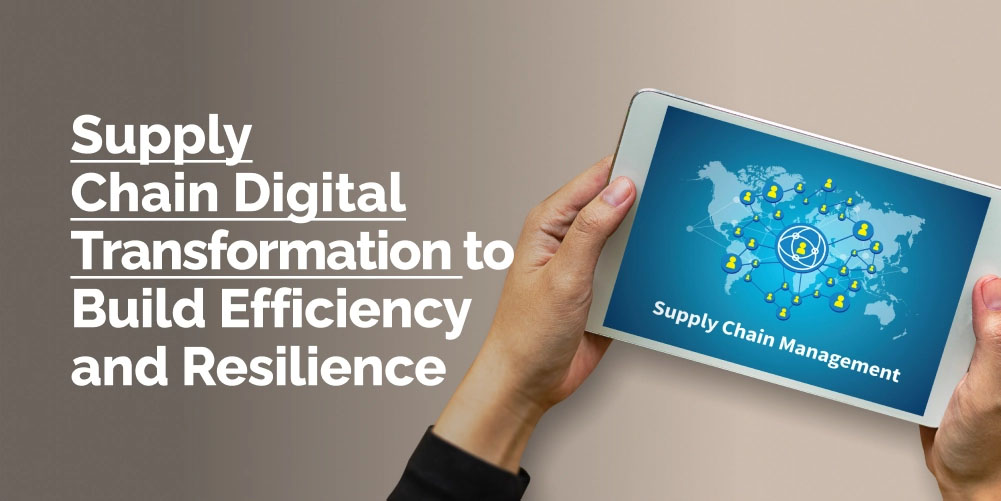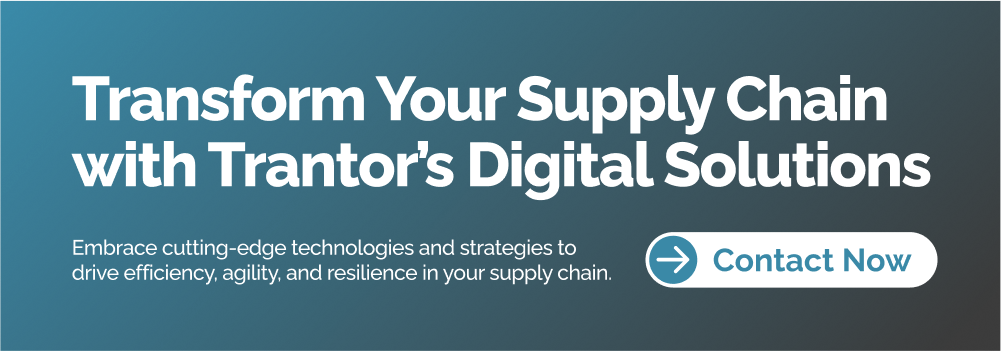Digital Transformation, zBlog
Supply Chain Digital Transformation: Navigating the Future of Efficient and Resilient Supply Chains
trantorindia | Updated: November 11, 2024

Introduction
In a world where global trade is increasingly complex and customer expectations are rising, traditional supply chain models are no longer sufficient. Businesses are grappling with challenges ranging from supply chain disruptions to increasing demand for transparency and efficiency. Supply Chain Digital Transformation is no longer just a buzzword but a critical strategy for businesses aiming to stay competitive and resilient.
Digital transformation in supply chain management involves integrating advanced technologies and data-driven approaches to optimize operations, enhance agility, and improve overall performance. This blog delves into the key aspects of supply chain digital transformation, exploring the benefits, challenges, and best practices for implementing these changes effectively.
1. Understanding Supply Chain Digital Transformation

Supply Chain Digital Transformation refers to the integration of digital technologies into every aspect of the supply chain to enhance efficiency, visibility, and agility. This transformation involves the use of advanced tools and methodologies to streamline processes, improve decision-making, and adapt to changing market conditions.
Key Technologies Driving Digital Transformation
- 1. Internet of Things (IoT): IoT devices enable real-time tracking of goods, equipment, and inventory. Sensors and connected devices provide valuable data on product conditions, location, and status, allowing for more accurate forecasting and inventory management.
- 2. Artificial Intelligence (AI) and Machine Learning (ML): Artificial Intelligence and Machine Learning algorithms analyze vast amounts of data to predict demand, optimize routing, and identify potential disruptions. These technologies help in making informed decisions and improving operational efficiency.
- 3. Blockchain: Blockchain technology ensures transparency and traceability in the supply chain. By providing an immutable ledger of transactions, blockchain enhances security, reduces fraud, and improves accountability across the supply chain.
- 4. Robotic Process Automation (RPA): RPA automates repetitive tasks such as order processing and data entry. This not only reduces errors but also frees up human resources for more strategic tasks.
- 5. Advanced Analytics: Advanced analytics tools analyze historical data to provide insights into trends, patterns, and anomalies. These insights help in optimizing supply chain strategies and improving decision-making.
2. The Benefits of Supply Chain Digital Transformation

Implementing digital transformation in the supply chain offers a range of benefits, including:
- Enhanced Efficiency and Productivity
Digital tools streamline operations by automating routine tasks and providing real-time data. This leads to faster decision-making and improved process efficiency. For example, IoT sensors can monitor inventory levels and automatically trigger reorders, reducing stockouts and overstock situations. - Improved Visibility and Transparency
Digital transformation provides end-to-end visibility of the supply chain. Companies can track goods from the point of origin to the final destination, gaining insights into every stage of the supply chain. This transparency helps in identifying bottlenecks, reducing delays, and improving overall performance. - Increased Agility and Responsiveness
With real-time data and predictive analytics, businesses can respond quickly to changes in demand, supply disruptions, and market trends. Digital tools enable companies to adjust their strategies on the fly, ensuring they remain competitive and responsive to customer needs. - Cost Reduction and Optimized Resource Utilization
By automating processes and optimizing supply chain operations, companies can reduce operational costs and make better use of their resources. For instance, advanced analytics can help in optimizing transportation routes, reducing fuel consumption, and lowering logistics costs. - Enhanced Customer Experience
Digital transformation allows for better alignment between supply chain operations and customer expectations. Companies can offer more accurate delivery estimates, improve order fulfillment accuracy, and enhance customer experience.
3. Challenges in Supply Chain Digital Transformation

While the benefits of digital transformation are significant, businesses may encounter several challenges during implementation:
- Integration with Legacy Systems
Many organizations still rely on legacy systems that may not be compatible with modern digital technologies. Integrating new digital tools with existing systems can be complex and require significant investment. - Data Security and Privacy Concerns
With the increased use of digital technologies, data security becomes a major concern. Companies need to ensure that their data is protected from cyber threats and that privacy regulations are adhered to. - Change Management
Digital transformation often requires significant changes in processes and culture. Employees may need training to adapt to new technologies, and resistance to change can impact the success of the transformation efforts. - High Initial Investment
Implementing digital technologies can involve substantial upfront costs. Businesses must carefully evaluate the return on investment (ROI) and ensure that the benefits outweigh the costs.
4. Best Practices for Successful Digital Transformation

To navigate the challenges and maximize the benefits of supply chain digital transformation, companies should follow these best practices:
- Develop a Clear Strategy
Start by defining a clear digital transformation strategy that aligns with your business goals. Identify key areas for improvement and prioritize the technologies and processes that will have the most significant impact. - Invest in the Right Technologies
Choose technologies that are compatible with your existing systems and scalable to meet future needs. Conduct thorough research and select solutions that offer the best fit for your supply chain requirements. - Foster a Culture of Innovation
Encourage a culture that embraces change and innovation. Provide training and support to employees to help them adapt to new technologies and processes. Create an environment where continuous improvement is valued. - Focus on Data Security
Implement robust security measures to protect your data from cyber threats. Ensure compliance with data privacy regulations and regularly review and update your security protocols. - Monitor and Measure Success
Track the performance of your digital transformation initiatives using key performance indicators (KPIs). Regularly review progress and make adjustments as needed to ensure that your transformation efforts are delivering the desired results.
5. Case Studies: Successful Supply Chain Digital Transformation
- Case Study 1: Walmart
Walmart has leveraged digital transformation to enhance its supply chain operations significantly. By implementing IoT sensors and advanced analytics, Walmart has improved inventory management, reduced supply chain costs, and increased operational efficiency. Their use of blockchain technology has also enhanced transparency and traceability, ensuring the integrity of their supply chain. - Case Study 2: Maersk
Maersk, a global leader in shipping and logistics, has embraced digital transformation to optimize its supply chain. By adopting blockchain technology for documenting transactions and using AI for predictive analytics, Maersk has improved its operational efficiency and reduced delays in its shipping processes. - Case Study 3: Unilever
Unilever has successfully integrated digital technologies into its supply chain to drive sustainability and efficiency. The company uses advanced analytics to optimize its supply chain operations and IoT devices to monitor product conditions. Unilever’s digital transformation efforts have led to reduced waste, improved supply chain visibility, and enhanced overall performance.
6. The Future of Supply Chain Digital Transformation

As technology continues to evolve, the future of supply chain digital transformation will likely see even more advanced innovations. Emerging technologies such as 5G, quantum computing, and augmented reality (AR) are expected to play a significant role in shaping the future of supply chain management.
- Embracing Innovation
Companies that embrace these innovations will be better positioned to stay ahead of the competition and meet the growing demands of the market. By continuously investing in new technologies and adapting to changing trends, businesses can ensure that their supply chains remain agile, efficient, and resilient. - Building Resilience
The COVID-19 pandemic has highlighted the need for supply chains to be resilient and adaptable. Future supply chain transformations will focus on building resilience to withstand disruptions and ensure continuity in the face of unforeseen challenges.
Conclusion
Supply Chain Digital Transformation is a critical strategy for businesses looking to enhance efficiency, agility, and resilience in their supply chain operations. By leveraging advanced technologies and data-driven approaches, companies can optimize their processes, improve decision-making, and stay competitive in an increasingly complex global market.
For businesses like Trantor, embracing digital transformation is not just about adopting new technologies but about creating a culture of innovation and continuous improvement. By following best practices and learning from successful case studies, companies can navigate the challenges and reap the benefits of a digitally transformed supply chain.
As we move forward, the ability to adapt and innovate will be key to success. Companies that invest in digital transformation today will be better positioned to thrive in the future, driving sustainable growth and delivering exceptional value to their customers.




